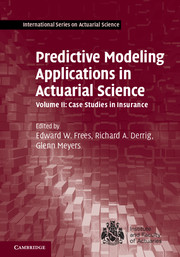Book contents
- Frontmatter
- Contents
- Contributors
- Preface
- Acknowledgments
- 1 Pure Premium Modeling Using Generalized Linear Models
- 2 Applying Generalized Linear Models to Insurance Data: Frequency/Severity versus Pure Premium Modeling
- 3 Generalized Linear Models as Predictive Claim Models
- 4 Frameworks for General Insurance Ratemaking: Beyond the Generalized Linear Model
- 5 Using Multilevel Modeling for Group Health Insurance Ratemaking: A Case Study from the Egyptian Market
- 6 Clustering in General Insurance Pricing
- 7 Application of Two Unsupervised Learning Techniques to Questionable Claims: PRIDIT and Random Forest
- 8 The Predictive Distribution of Loss Reserve Estimates over a Finite Time Horizon
- 9 Finite Mixture Model and Workers’ Compensation Large-Loss Regression Mixture Model and Workers’ Compensation Large-Loss Regression Analysis
- 10 A Framework for Managing Claim Escalation Using Predictive Modeling
- 11 Predictive Modeling for Usage-Based Auto Insurance
- Index
- References
11 - Predictive Modeling for Usage-Based Auto Insurance
Published online by Cambridge University Press: 05 August 2016
- Frontmatter
- Contents
- Contributors
- Preface
- Acknowledgments
- 1 Pure Premium Modeling Using Generalized Linear Models
- 2 Applying Generalized Linear Models to Insurance Data: Frequency/Severity versus Pure Premium Modeling
- 3 Generalized Linear Models as Predictive Claim Models
- 4 Frameworks for General Insurance Ratemaking: Beyond the Generalized Linear Model
- 5 Using Multilevel Modeling for Group Health Insurance Ratemaking: A Case Study from the Egyptian Market
- 6 Clustering in General Insurance Pricing
- 7 Application of Two Unsupervised Learning Techniques to Questionable Claims: PRIDIT and Random Forest
- 8 The Predictive Distribution of Loss Reserve Estimates over a Finite Time Horizon
- 9 Finite Mixture Model and Workers’ Compensation Large-Loss Regression Mixture Model and Workers’ Compensation Large-Loss Regression Analysis
- 10 A Framework for Managing Claim Escalation Using Predictive Modeling
- 11 Predictive Modeling for Usage-Based Auto Insurance
- Index
- References
Summary
Chapter Preview. Usage-based auto insurance, also known as UBI, involves analyzing data collected from policyholders’ vehicles via telematics to help determine premium rates. Behavioral information considered includes vehicles’ speeds, maneuvers, routes, mileage, and times of day of operation. UBI has been described as a potentially significant advancement over traditional techniques that rely on information such as policyholders’ ages as proxies for how riskily they drive. However, because data collected via telematics are volatile and voluminous, particular care must be taken by actuaries and data scientists when applying predictive modeling techniques to avoid overfitting or nonconvergence and to improve predictive power. In this chapter, we use a case study to evaluate how modeling techniques perform in a UBI environment and how various challenges may be addressed.
Introduction to Usage-Based Auto Insurance
Background
Usage-based auto insurance, more commonly known as UBI, represents a significant evolution in automobile insurance pricing. The mathematical approaches underlying UBI rating plans do not differ significantly from those used historically, but the information utilized is much more granular, presenting unique challenges. Traditionally, automobile rating plans have considered data elements such as a vehicle operator's age, the type of vehicle, and the region in which the vehicle is garaged in a multivariate context to estimate expected losses. Those variables are generally considered as rough proxies for how responsibly the vehicle is operated or the types of traffic conditions to which it may be subject. Since the number of such proxies is typically relatively small (e.g., dozens), the ability to differentiate between high- and low-risk policyholders is limited, and cross-subsidies are to some extent unavoidable. In contrast, advanced UBI assesses risk factors more precisely using a large number of variables produced by in-vehicle technology called telematics.
Policyholders participating in UBI authorize their insurers to use telemetrically collected information such as (vehicles’)speeds, maneuvers, times of day of operation, and routes to help determine premium rates in future policy periods. This information essentially allows for the extraction of a dynamic “safe driving resume” for each policyholder vehicle. Whereas a vehicle operator's age or the region where he garages his vehicle is fairly static, and may change once or not at all each policy period, the quantities associated with UBI are collected at intervals as frequent as dozens of times per second for advanced implementations.
- Type
- Chapter
- Information
- Predictive Modeling Applications in Actuarial Science , pp. 290 - 308Publisher: Cambridge University PressPrint publication year: 2016
References
- 2
- Cited by



